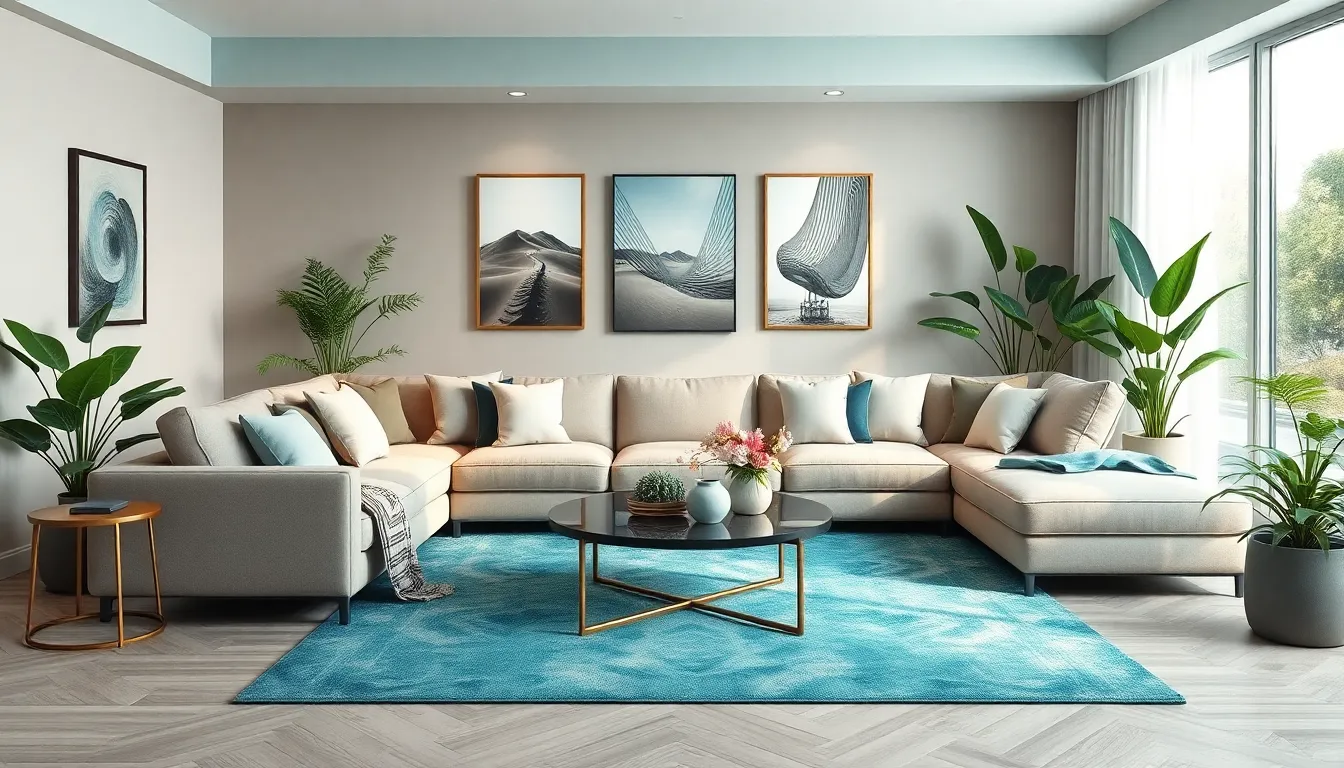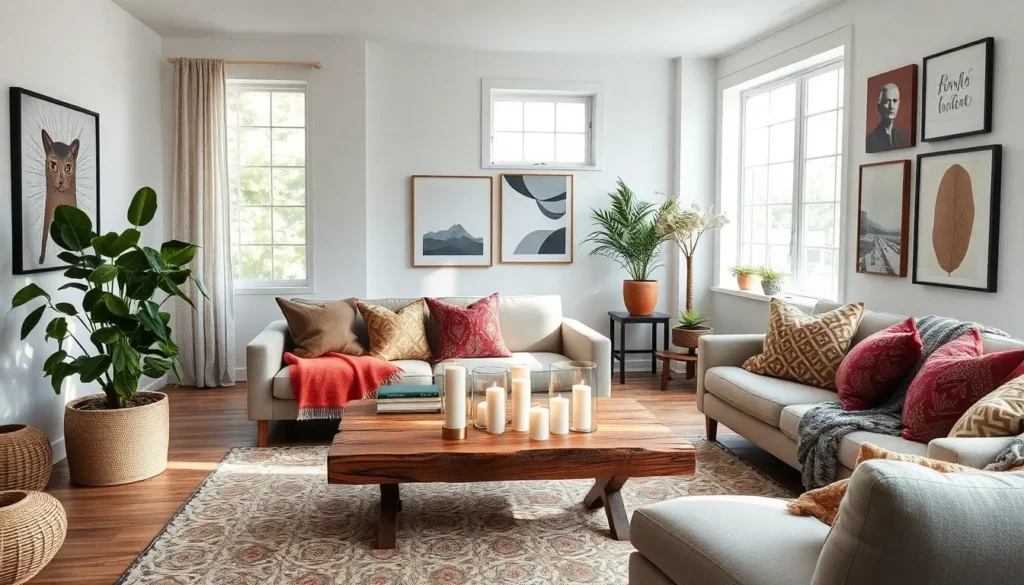Table of Contents
ToggleHome decor transforms a house into a home, reflecting personal style and creating a welcoming atmosphere. From choosing the right color palette to selecting furniture and accessories, every decision plays a crucial role in setting the tone of a space. With endless options available, it can be overwhelming to know where to start.
In recent years, home decor trends have evolved, embracing sustainability and minimalism while celebrating individuality. Whether it’s incorporating vintage pieces or opting for modern designs, the choices are as diverse as the people who make them. Understanding the latest trends and timeless principles can help anyone curate a space that feels uniquely theirs.
Overview of Home Decor Trends
Home decor trends continue to evolve, influencing how individuals personalize their spaces. Key styles, such as modern minimalism, bohemian, and rustic chic, highlight diverse approaches to creating inviting environments.
Modern Minimalism
Modern minimalism emphasizes simplicity, functionality, and clean lines. Designers focus on a neutral color palette, using shades like white, gray, and beige. Furniture selection prioritizes multi-functional pieces that maximize space efficiency. Decor often includes geometric shapes and unobtrusive accessories, allowing natural light to enhance room brightness. This trend promotes a clutter-free atmosphere, encouraging mindfulness in home design.
Bohemian Style
Bohemian style embodies eclecticism and artistic expression. Rich colors, layered textiles, and unique accessories create a warm, inviting feel. Patterns and textures, such as woven rugs and ethnic prints, play significant roles in achieving this look. Furniture often features vintage finds, adding character and individuality. Plants are essential, bringing the outdoors inside and enhancing overall vitality in the decor.
Rustic Chic
Rustic chic blends charm with modern aesthetics, creating cozy yet sophisticated environments. Natural materials like wood and stone dominate this style, promoting an earthy appeal. Color schemes typically include muted tones, such as browns, greens, and grays. Furniture often showcases distressed finishes or handmade elements, contributing to a lived-in feel. Decorative accents might incorporate farmhouse elements, combining old-fashioned ideas with contemporary trends.
Essential Home Decor Elements

Home decor significantly influences a home’s ambiance. Various elements contribute to this transformation, including color schemes, furniture selection, and textiles and accessories.
Color Schemes
Color schemes set the foundational tone of a room. Choosing a cohesive palette can create harmony or contrast, depending on the desired effect. Neutrals such as beige and gray provide a calming backdrop, while bold colors like teal or mustard inject personality. Each color evokes different emotions; for example, blues can promote tranquility, while yellows can energize a space. Utilizing accent colors through accessories, such as pillows or artwork, enhances interest without overwhelming the area.
Furniture Selection
Furniture selection defines both functionality and style. Prioritize multi-functional pieces, especially in smaller spaces, allowing for versatility. Modular sofas, extendable dining tables, and storage ottomans maximize usage while minimizing clutter. Selecting furniture that reflects personal style—whether modern, vintage, or transitional—helps establish a cohesive look. Ensure comfort and quality, as well-chosen furniture serves as the backbone of a welcoming and stylish environment.
Textiles and Accessories
Textiles and accessories add depth and comfort to home decor. Layering rugs, curtains, and cushions introduces texture and warmth. Fabrics like cotton and linen are breathable and durable, while velvet and wool can create a more luxurious feel. Accessories such as artwork, mirrors, and decorative objects provide visual interest and personalize the space. Incorporating plants as natural accessories enhances air quality and introduces lively elements, connecting indoor spaces to nature.
DIY Home Decor Ideas
Unlocking creativity at home can be both fun and economical. Here are some innovative DIY home decor ideas that enhance personal spaces without heavy expenses.
Budget-Friendly Projects
- Wall Art: Create wall art using canvas, paint, or magazine clippings. Arrange multiple pieces for an eclectic gallery.
- Mason Jar Organizers: Use mason jars to organize small items on shelves or desks. They add charm while serving practical purposes.
- Cushion Covers: Sew or craft cushion covers from fabric remnants. Choose vibrant colors and patterns to refresh seating areas.
- Flower Arrangements: Assemble artificial flowers into unique vases. This provides color and freshness without the upkeep of real plants.
- Painted Furniture: Give old furniture a new lease on life with a fresh coat of paint. This can create standout pieces that captivate attention.
Repurposing Old Items
- Wine Crate Shelves: Transform wine crates into shelves. They add rustic appeal and provide functional storage.
- Old Ladder Displays: Repurpose an old ladder to showcase books or plants. Lean it against a wall for a stylish display.
- Tire Ottoman: Cover an old tire with fabric to create a chic ottoman. It blends eco-friendliness with modern design.
- Picture Frame Collage: Create a picture frame collage using mismatched frames. Paint them in a uniform color for a cohesive look.
- Tin Can Desk Organizer: Clean and decorate tin cans to organize office supplies. This is both eco-friendly and customizable.
Professional Home Decor Tips
Expert strategies enhance home decor and provide personalized styles. Implementing the right techniques will elevate any space significantly.
Hiring an Interior Designer
Hiring an interior designer can streamline the decoration process. Designers assess a home’s unique features and create tailored design plans that maximize space and functionality. They offer insights into color theory, furniture selection, and layout optimization.
Choosing a designer requires evaluating their past work and understanding their design philosophy. Most professionals provide portfolios that showcase their style, helping homeowners find the perfect match. Consulting with multiple designers ensures balanced perspectives and varied ideas.
Signing a contract with clear terms protects both parties, detailing fees and timelines. Open communication throughout the project encourages collaboration and adaptability, ensuring the final outcome aligns with the homeowner’s vision.
Utilizing Online Resources
Utilizing online resources broadens creative possibilities for home decor. Websites and apps like Pinterest and Houzz provide vast inspiration through user-generated content. These platforms enable users to explore diverse design styles and save favorite ideas.
Online tutorials offer step-by-step guidance for DIY projects, making them accessible for various skill levels. Video platforms demonstrate installation techniques, painting tips, and craft possibilities that enhance decor without hiring professionals.
Virtual room planners allow homeowners to visualize design choices in their spaces. Programs can help experiment with colors, furniture placements, and layouts, ensuring informed decisions before purchasing. Read reviews and explore forums for product feedback and tips from fellow decorators, bolstering confidence in decor choices.
Home decor is more than just aesthetics; it’s about creating a space that resonates with individual style and comfort. By embracing current trends like modern minimalism and bohemian flair, anyone can curate an environment that feels uniquely theirs.
DIY projects offer an affordable way to personalize spaces while promoting sustainability. Professional guidance can further enhance the process, ensuring that every element works harmoniously.
Ultimately, thoughtful decor choices can transform a house into a home, making it a true reflection of those who live within its walls.




